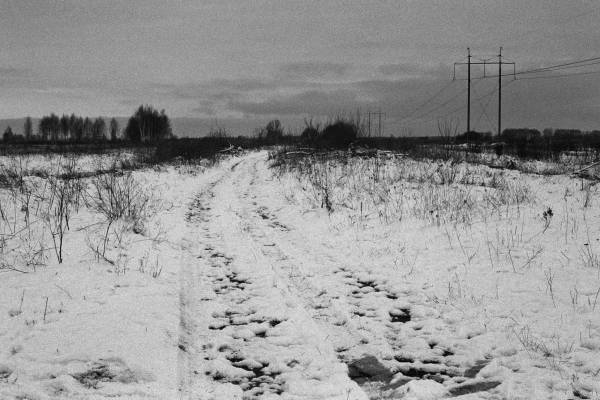
 Giovanni V.R. Sorge
Giovanni V.R. Sorge
The Mission of Memory. Christian Herrmann on the traces of the ‘Hidden Holocaust’ * (Leggi la versione in Italiano )
German photograph and blogger Christian Herrmann (see his blog Vanished World) documents long-forgotten traces and sites of Jewish heritage in Eastern Europe. For his extensive work to counter this slide into oblivion, 2021 he was awarded with the German Bundesverdienstkreuz (Federal Cross of Merit).
There is an area vertically transecting Eastern Europe that includes territories which American historian Timothy D. Snyder calls “Bloodlands” in his eponymous book (2010): it was here that Hitler and Stalin’s megalomania and imperial plans erupted with the utmost force. Christian Herrmann had extensively traveled in those areas, capturing with his camera the traces of a heavily repressed geo-political history of the last century: his photos show Western Europe's abandoned Jewish heritage sites, cemeteries often devoured by weeds, remains of synagogues in the center or outskirts of Ukraine, and mass graves remembered by few: all this attests to a past that is just fleetingly mentioned, and sometimes completely omitted in the history books: they are traces of, in the words of Father Patrick Desbois, “the Hidden Holocaust”. (see https://www.cbsnews.com/news/hidden-holocaust-60-minutes/).
The boundaries of the countries visited by Christian were repeatedly moved, re-created, or eliminated. Galicia and Bukovina formed part of the Austro-Hungarian Empire. After its demise, At one point, they became part of Poland and Romania, while Podolia passed from the rule of Tsarist Russia to the Soviet Union. Nowadays Eastern Galicia, the northern regions of Bukovina and Podolia belong to Ukraine, while Western Galicia and South Bukovina belong to Poland and to Romania. Should we take the time to look even further back, we would find traces of numerous other dominations including the Ottoman Empire, the Cossacks, and the Tatars. For centuries, these regions were characterized by diversity and multi-ethnicity: Ukrainians, Poles, Romanians, Russians, Czechs, Hungarians, Germans, Jews, Roma, and Armenians formed an extraordinary melting pot. Today, Herrmann’s photos bring to light – and to our memories – death, destruction, and genocide. They force us to grapple with the deep, tragic dilemma inherent in Terence's famous quotation, “I am human, and nothing of that which is human is alien to me” (Terence, Heauton Timorumenos, Act I, sc. 1, l. 25).
The Jews were to pay the highest price, victims of exterminations that continued the genocide of Auschwitz, Buchenwald and other concentration camps. However, in this case, Christian writes, there was no
“industrial, anonymous killing. The majority of Galician Jews were murdered in their homes and not in concentration camps. After a first wave of pogroms by nationalists and neighbors, the Einsatzgruppen of the SS followed with their practice of mass- massacre. There was nothing industrial or anonymous about these deaths. They were carried out with firearms at close range; they were executed with axes, saws and even barehanded; or they resulted from hunger and typhus. They occurred face to face with the victims”.
One and a half million Jews were killed solely in the territory of Ukraine between 1941 and 1945 (in Western Ukraine for the most part). And, after the bloodbath by the Nazis and their allies, the Soviet domination resumed the destruction and tried to erase all traces by building or transforming existing cultural constructions: occasionally, cemeteries were replaced by cinder block buildings, synagogues transformed into cinemas, swimming pools or similar structures, etc. With their bulky silence these ruins speak of an unbearable past, all the more so if repressed and denied.
In particular, Christian pointed out to me two photos which he finds particularly relevant: the first one shows a snow-covered road in Trachimbrod (Trochenbrod), Ukraine leading to a no man’s land. In place of this desert there used to be a city that has been destroyed. Not a single trace of it remains today. The second one depicts a wood near Lwiw (Lemberg) at Lisinitschi in Galicia (Ukraine). These trees were planted by the Germans after they had massacred 90,000 people, many of them Jews. Today families come here for barbecues, unaware of this tragedy; and indeed no memorial has been erected to acknowledge it.
In the interactive rhythms of our post-modern, increasingly cybernetic society, space seems to be liquefied (Zygmunt Baumann) at the expense of time. Instead, in the places Christian has visited, he says, “One becomes painfully aware of space”. Entering the ruins of synagogues, cemeteries and Hasidic courts, one can see that “Time is not a linear movement forward. It can also run in reverse and can take us on a journey into the past”. This is the great value of Christian's journeys through countries – and cities such as Riga, Warsaw, Wilna, Krakow, Lemberg – that did not belong to the ranks of the classic Grand Tour made by the aristocracy and bourgeoisie of pre- and post-romantic Europe. Christian's extraordinary expeditions are reported in his blog “Vanished World” – that is, a reference to the eponymous book by the American-Polish-Jewish photographer Roman Vishniac of 1983, which records Jewish life in Germany immediately prior to the Holocaust. Herrmann’s work pays homage to this book and his photos, in a way, integrate the previous documentation.
***
The well-known phrase “a picture is worth a thousand words” is particularly appropriate here. One remains speechless before these images, before the tangible sense of silence surrounding these ruins, lands, cemeteries. They show traces of a journey that delves into the blood-soaked roots of wars, totalitarianism and nationalism. These images dramatically require us to remember.
“Remember” comes from the Latin “rememorari”, from “re” (“back, again”) and “memorari” (“be mindful of”; from “memor”, namely “mindful”); it means “recall to mind”, and signifies a process, which assumes different connotations depending on different languages: in Italian “ricordare” – as well as in Spanish, “recordar” – comes from the Latin “re-cordari” (from “cor”, hearth), which means “to bring back to the heart”. Instead in French “souvenir” indicates a memory rising from below (“sub-venire”, “to come from below”), from the unconscious perhaps (yet they also say “apprendre par coeur” or “to know by hearth”). This suggests a process that requires going through, but also beyond, the “Cartesian” mind and digging into the deeper psyche.
In an essay of 1914 (Remembering, Repeating and Working-Through) Freud wrote that “Erinnern” (“remembering”) must be followed by “Durcharbeiten” (“work out”, “through”). Thus, the repressed elements in the unconscious can be brought to the light and freed from the “Wiederholungszwang” (“repetition compulsion”). Can this be the case in both the individual setting and in the elaboration processes of collective, socio-political events? There are good reasons to doubt that history is – as one always hopefully expects it to be – “magistra vitae.” However, any work carried out on memory, remembrance and awareness according to the vast tradition of psychoanalytic thought – and possibly enriched by the tradition of critical thinking eminently represented by the Frankfurt School Critical Theory – can lead to a better understanding of collective history, with its cultural (national and nationalistic) complexes and its manipulations made both by political agendas and by the holders of “official” history. Not by accident, the psychoanalyst and historian Regine Lockot took inspiration from this Freud’s essay for her seminal book on the history of psychoanalysis and psychotherapy during the Third Reich (R. Lockot, Erinnern und Durcharbeiten. Zur Geschichte der Psychoanalyse und Psychotherapie im Nationalsozialismus, 1985).
It is always the way of how the past is narrated – in a word, the story-telling and, if one might say, the story-re-telling i.e. re-narrating – that allows us to discern the present (and to look into the future). Just to mention a few cinematic examples: the movie Son of Saul by Lazlo Nemes (2015) narrates the Holocaust through the eyes of a member of the so-called “Sonderkommandos”, the labor units of prisoners, usually Jews, whom the Nazis forced to work in the mechanisms of extermination (Primo Levi in The Drowned and the Saved called them “the crematorium ravens”). It is the story of a non-hero. A completely different narrative was developed in Steven Spielberg’s “Schindler’s List” (1993); or in Roberto Benigni’s “La Vita è Bella” (1997). The first depicts the story of the German businessperson Oskar Schindler, who managed to save almost 1200 Jews from concentration camps; the second represents the same atrocities almost as a kind of fairy tale in order to save the imagination – and perhaps the life – of a child interned in one such concentration camp.
Finally, one may recall the story of a man who has been called the “Italian Schindler”, narrated in The Banality Of Goodness: The Story of Giorgio Perlasca by Enrico Deaglio (1991), a book whose title meaningfully counters Hannah Arendt's key work (Eichmann in Jerusalem: A Report on the Banality of Evil, 1963). While Adolf Eichmann turns out to be the perfect representation of someone completely devoid of (moral) imagination, Perlasca, on the contrary, posed as the Spanish consul of Hungary, and in so doing, between December 1944 and January 1945, he saved over 5000 Jews from deportation to Nazi extermination camps. Perlasca said: “I think I did something normal, because I believe that in my situation anyone would have done the same. I can't imagine someone who, in my place, would have refused to do it." (“Io credo di aver fatto qualcosa di normale perché penso che nella mia situazione chiunque avrebbe fatto la stessa cosa. Non posso immaginare che ci sarebbe stata una persona, al mio posto, che avrebbe rifiutato di farlo.” my transl.)
Working with and on memory is possibly the only way to sow seeds of critical awareness and moral imagination, so that such horrors will not be repeated, albeit in new forms, perhaps more subtle and seemingly harmless, or even seductive in nature. As the Italian actor and playwright Moni Ovadia poignantly states, “To remember is an instrument for building the present and the future. (…) One of the traits of humanity is that it can never reach a final goal. If it fails to pay attention, if it does not constantly work on itself, it runs the risk of going backward” (“Fare memoria è uno strumento per costruire il presente e il futuro. (…) Una delle caratteristiche dell’umanità è che non conquista mai una cosa una volta per tutte. Se non vigila, se non lavora su sé stessa rischia di tornare indietro.”; my transl.)
Having received “the highest recognition that the Federal Republic of Germany expresses for services to the common good,” Christian Herrmann hopes that his work will help to direct more attention to Eastern Europe’s Jewish heritage. As he writes in his blog, he wishes to “recall those places back into public consciousness and wants to encourage people to rescue a heritage we all share.”
Giovanni Sorge
References and Selected Bibliography
On the subject
See also:
Psychoanalytic References and other quoted Works and webpages
Film
* This article was originally part of a series of exhibition presentations which were held at the Stillpoint Spaces in Zurich in 2016. For a considerable part of the information and insights contained herein I am indebted to Chistian Herrmann himself and to his book Spurensuche. Jüdisches Kulturerbe in der Westukraine. Mit Texten von Jürgen Wilhelm und Lothar Altringer, 2015.
My thanks to the late Donatella Buonassisi for her careful review
